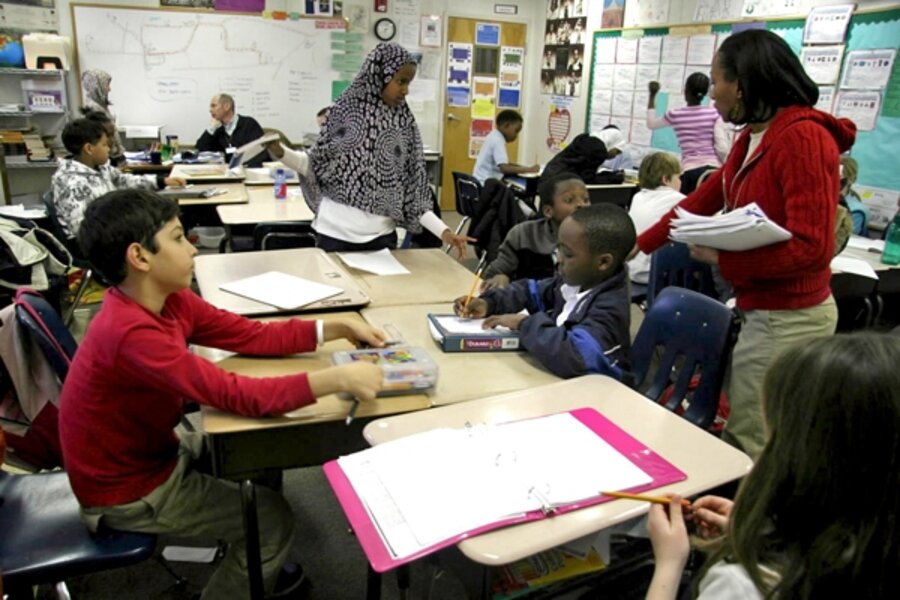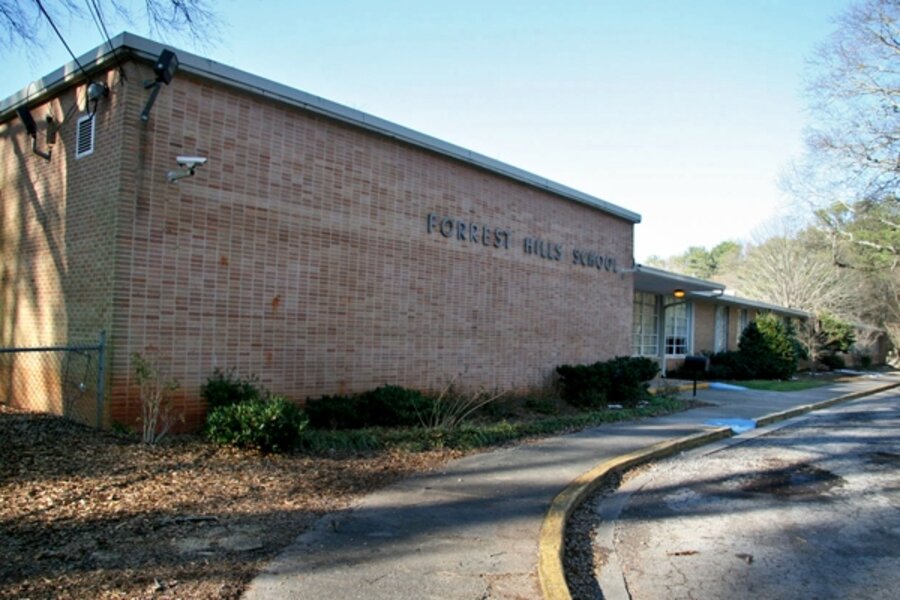Charter schools’ biggest crisis: A place to call home
Loading...
| Decatur, Ga.
The school is bursting at the seams. Desks are packed so tightly in trailer classrooms that a fourth-grader at the International Community School (ICS) can scarcely slip out for a drink of water without knocking into someone.
Fifth- and sixth-graders are on a separate campus, seven miles from their siblings in kindergarten through fourth. Some administrators work out of hallways and closets. The school's 400 US-born and refugee students can't gather anywhere but outdoors for celebrations or assemblies.
On rainy days, 20 kids squeeze in for PE on one side of the noisy cafeteria, while 120 schoolmates eat on the other.
To top it all off, a steeple and cross rise from the building near the entrance to the public charter school's main campus.
ICS needs a new home.
A mile away, in a quiet, residential neighborhood, a roomy public school building stands tantalizingly empty. The DeKalb County school district won't rent or sell it to ICS - a precedent other charter schools might want to follow.
So the 7-year-old school is looking farther afield - well beyond the community it now serves - for a permanent home. Some teachers, parents, and staff fear the school's commitment to refugee kids like Bill Clinton Hadam could be lost in the move."I don't want us to eat our souls in this process," said fifth-grade teacher Claire Hamilton, last month choking up in a staff meeting about the school's future.ICS's struggle is part of a nationwide crisis for charter schools. Even as President Obama plans to increase federal funding for charter schools, experts say that the lack of facilities and money for facilities will keep dozens from opening this year - and alter, or close, many more."It's possibly the greatest constraint on our growth as a movement," says Nelson Smith, president of the National Alliance for Public Charter Schools.
Avondale Pattillo United Methodist Church, ICS's main landlord, gets the best and worst of the school: The joy of watching a United Nations of kids they're helping to educate at play outside their windows. And the dust bowl that hundreds of small sneakers have made of the pecan grove out back. The church backs up against a large, crime-ridden apartment complex that is many refugee families' first experience of the US. Members see supporting ICS as a tangible way to "love thy neighbor."
"We couldn't have opened without the church, period," says ICS cofounder Bill Moon. It's hard to have a public school in church-owned buildings though; many families are wary.
In Georgia, charter schools get no local or federal help with buying, renting, or maintaining buildings. In each of the past three years, less than $1 million of state grants for charter facilities has been available to 36 schools. Indeed, only one district in the nation, Washington, D.C., funds charter facilities on the same per-pupil basis as other public schools.
ICS has an incredible deal renting from Avondale Pattillo and St. Michael & All Angels Episcopal Church for its fifth and sixth grades: between $1 and $3.65 per square foot of space, while comparable properties rent for $18 to $21 a square foot. Still, the school spends 17 percent of its annual budget on facilities. Parents, staff, and donors agree: It's not sustainable.
The idea has always been a single campus with spacious rooms, a grassy soccer field, and an auditorium. The search has meant much introspection and legwork. Does ICS want to be a more traditional school? A school-without-walls? The center of a mixed-income housing development? Partners with a local children's home?
Over the years, school leaders have visited more than 20 possible sites: a funeral home, an Elks Lodge, strip malls, and any number of plots of land. In 2006, they thought they'd found it. DeKalb County announced plans to close Forrest Hills, an elementary school a mile away from Avondale Pattillo, because of low enrollment.
Neighbors collected 1,500 signatures to persuade the county to lease or sell it to ICS, whose presence they felt would stabilize the area. Superintendent Crawford Lewis was flooded with letters from citizens and community leaders. DeKalb's state legislators sponsored a resolution in support of the plan.
After a year, Superintendent Lewis decided to keep the building long term. He asked ICS to write a business plan showing the school could afford to rent it - at rates six times what ICS was paying. In the end, ICS withdrew its request.
"I felt like it was a slap in the face," says Denise Reidy-Puckett, a leader of the effort. For years, as a volunteer in local schools, she'd heard county leaders ask for community support and parent involvement. "Well, here was this huge outpouring, and they just turned their backs," she says.
"It all goes back to the fact that the school district is not seeing the charter school as the real partner that they are. They're not competition," says Tony Roberts, president of the Georgia Charter Schools Association. "If they saw them as a partner, they would give the school to them."
County officials say they wish it were that simple. In Georgia, school building and upkeep is funded by local sales taxes, so wealthy exurban districts are building megaschools, while stagnant districts with old buildings and large low-income populations, like DeKalb, are hurting.
The school district has over $2 billion in needed repairs to aging buildings. Its 2010 allotment is $1.5 million: "[Enough for] a half a school," says Patricia Pope, chief operations officer for the schools.
DeKalb County schools spokeswoman Julie Rhame sympathizes. ICS is a model school, she says, but the county is also responsible for 152 others, and "we're all pulling from the same dry well."
Five other charter schools in the district could also use facilities help. "If you do it for ICS, you have to do it for everyone else," she says.
The county hoped to open a single-sex middle school in the Forrest Hills building this fall, but budget woes put that on hold. Meantime, the building stands empty at a cost of $48,000 per year - while ICS rents both its campuses for $77,000 annually.
"It doesn't make any sense," says Andrew Broy, Georgia Department of Education associate superintendent of charters.
In Georgia, and nationwide, says Mr. Smith, of the charter school alliance, the problem has its roots in charter laws. "Some folks said we could do it on the cheap, which turns out to have been a mistake. And also I think that there was maybe not a clear understanding of what charter schools would need," he explains.
"A lot of people, including policymakers, tend to think of charter schools as cute little boutique schools that can operate out of church basements or storefronts."
In reality, as charters grow, the students need the facilities any public school is expected to offer - and the funding, says Smith.
Principal Laurent Ditmann has hired a consultant to devise a five-year strategic plan. The consensus of staff, parents, and donors after the first draft: Besides "academic excellence," a new facility is the top priority. By fall 2010, ICS plans to cut sixth grade and be either in a new building, or contracted onto a single campus. This would mean cutting staff and students because Avondale Pattillo is at capacity, with classroom trailers on all available land. Rather than see that happen, school leaders have been working overtime to find ICS a new home.
Last month, on a visit to one potential facility, a group of staff and parents oohed and aahed over the high ceilings and huge library. The downside: It's 10 traffic-clogged miles from many refugees the school now serves in Clarkston.
Astonishingly, with the world economy in free-fall, ICS may now be in a good position to buy a building. Last month, parent-activist Marney Mayo and Dr. Ditmann met with a team from Self-Help, a national community development bank that lends in low-income and underserved communities.
"So ICS is right in our sweet spot," says loan officer Steve Saltzman. He and director of charter school lending Jane Ellis were impressed with the school's budget projections. "I'm not scared of this," Mr. Saltzman said. They said they'd be willing to consider a loan to ICS to buy a $3 million to $5 million facility - not extravagant, but in today's market, not impossible to find.
Though Forrest Hills seems to be off the table, another possibility may be emerging. Tonight, Ms. Pope, of the county school district, plans to ask the school board to close three more K-12 buildings. ICS hopes this could be a first step to selling off the old buildings - something the district hasn't done for decades.
Among them is Hooper Alexander Elementary School, 2-1/2 miles from ICS's current site. The school has its eye on the facility, with reservations: The 75-year-old building needs major repairs and is in a noisy location. Ms. Mayo, who's been a driving force in ICS's building search for years, is keeping an open mind: "I know there are rats in the basement. I don't know how big the rats are."
In the end, the search for a space is about more than just a building. It's about what a school wants to become. In this way, says Mayo, ICS's trajectory has been like the American experience of many of its refugee families: "You start out just so grateful to land someplace safe. Then there's the question of who you are."






